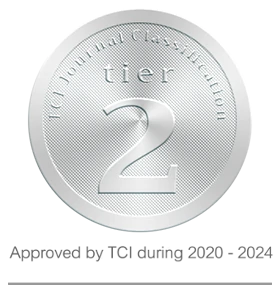Comparative Study of Union Rate in Closed Humerus Shaft Fracture After Operative Fixation with Anteromedial Versus Anterolateral Surface Plating Using the Anterolateral Approach: A Randomized Controlled Study
DOI:
https://doi.org/10.56929/jseaortho-2024-0217Keywords:
Humerus, Humerus shaft fracture, Anteromedial plating, Anterolateral plating, Anterolateral approachAbstract
Purpose: Plate osteosynthesis is considered the gold standard for treating humeral shaft fractures, and orthopedic surgeons widely use the anterolateral approach with anterolateral surface placement. However, surgeons may have difficulties with the non-smooth surface and proximity to the radial nerve during their use. To address this challenge, we propose introducing the anterolateral approach with anteromedial surface placement. This study aimed to compare the outcomes between anteromedial and anterolateral surface plating using the anterolateral approach.
Methods: This study included 74 patients who sustained a mid-shaft humerus fracture (AO 12) and underwent open reduction internal fixation between December 2020 and December 2022. Twelve patients were excluded based on the exclusion criteria. Among the remaining patients, 30 were randomized and allocated to surgery with anteromedial surface plating, while 32 patients were treated with anterolateral surface plating through an anterolateral approach. Postoperative clinical and radiographic results were recorded and analyzed.
Results: The union rate, blood loss, operative time, and complications were not significantly different between the two groups. All the patients healed radiographically except for two in the anterolateral surface plating group, who required reoperation. Although anteroposterior alignment was significantly better in the anteromedial surface plating group, it was not clinically significant.
Conclusions: Anteromedial plating demonstrated a commendable union rate, offered assured alignment, and presented itself as a secure option for addressing fractures of the humerus shaft.
Metrics
References
Ekholm R, Adami J, Tidermark J, et al. Fractures of the shaft of the humerus. An epidemiological study of 401 fractures. J Bone Joint Surg Br 2006;88:1469-73. DOI: https://doi.org/10.1302/0301-620X.88B11.17634
Sarmiento A, Kinman PB, Galvin EG, et al. Functional bracing of fractures of the shaft of the humerus. J Bone Joint Surg Am 1977;59:596-601. DOI: https://doi.org/10.2106/00004623-197759050-00004
Rämö L, Sumrein BO, Lepola V, et al. Effect of surgery vs functional bracing on functional outcome among patients with closed displaced humeral shaft fractures: The FISH randomized clinical trial. JAMA 2020;323:1792-801. DOI: https://doi.org/10.1001/jama.2020.3182
Orapiriyakul W, Apivatthakakul V, Theppariyapol B, et al. Humerus shaft fractures, approaches and management. J Clin Orthop Trauma 2023;43:102230. DOI: https://doi.org/10.1016/j.jcot.2023.102230
Blum J, Rommens PM. Surgical approaches to the humeral shaft. Acta Chir Belg 1997;97:237-43.
Klenerman L. Fractures of the shaft of the humerus. J Bone Joint Surg Br 1966;48:105-11. DOI: https://doi.org/10.1302/0301-620X.48B1.105
Mulier T, Seligson D, Sioen W, et al. Operative treatment of humeral shaft fractures. Acta Orthop Belg 1997;63:170-7.
Vander Griend R, Tomasin J, Ward EF. Open reduction and internal fixation of humeral shaft fractures. Results using AO plating techniques. J Bone Joint Surg Am 1986;68:430-3. DOI: https://doi.org/10.2106/00004623-198668030-00018
Rai SK, Sud AD, Kashid M, et al. Anteromedial surface plating for midshaft fracture humerus through an anterolateral approach - A better option than anterolateral plating. Malays Orthop J 2020;14:66-72. DOI: https://doi.org/10.5704/MOJ.2011.011
Liskutin T, Summers H, Lack W, et al. Surgical technique: Anterolateral approach to the humerus. J Orthop Trauma 2018;32 Suppl 1:S6-S7. DOI: https://doi.org/10.1097/BOT.0000000000001206
Whelan DB, Bhandari M, Stephen D, et al. Development of the radiographic union score for tibial fractures for the assessment of tibial fracture healing after intramedullary fixation. J Trauma 2010;68:629-32. DOI: https://doi.org/10.1097/TA.0b013e3181a7c16d
Harkin FE, Large RJ. Humeral shaft fractures: union outcomes in a large cohort. J Shoulder Elbow Surg 2017;26:1881-8. DOI: https://doi.org/10.1016/j.jse.2017.07.001
Milner SA. A more accurate method of measurement of angulation after fractures of the tibia. J Bone Joint Surg Br 1997;79:972-4. DOI: https://doi.org/10.1302/0301-620X.79B6.7458
Sanjay M, Raf M, Goud H, et al. Medial plating of humerus shaft fractures through anterolateral approach. IOSR Journal of Dental and Medical Sciences 2017;16:18-23. DOI: https://doi.org/10.9790/0853-1604011823
Vijayashankar M, Jayaprakash BA, Arumugam B. A prospective analysis of functional outcome of humeral diaphyseal fractures treated with dynamic compression plate. International Journal of Contemporary Medical Research 2016;3:2725-8.
Qu X. Morphological effects of mechanical forces on the human humerus. Br J Sports Med 1992;26:51-3. DOI: https://doi.org/10.1136/bjsm.26.1.51
Apivatthakakul T, Arpornchayanon O, Bavornratanavech S. Minimally invasive plate osteosynthesis (MIPO) of the humeral shaft fracture. Is it possible? A cadaveric study and preliminary report. Injury 2005;36:530-8. DOI: https://doi.org/10.1016/j.injury.2004.05.036
Müller ME. Treatment of nonunions by compression. Clin Orthop Relat Res 1965;43:83-92. DOI: https://doi.org/10.1097/00003086-196500430-00009
Ambrósio J, Quental C, Pilarczyk B, et al. Multibody biomechanical models of the upper limb. Procedia IUTAM 2011;2:4-17. DOI: https://doi.org/10.1016/j.piutam.2011.04.002
Zheng YF, Zhou JL, Wang XH, et al. Biomechanical study of the fixation strength of anteromedial plating for humeral shaft fractures. Chin Med J (Engl) 2016;129:1850-5. DOI: https://doi.org/10.4103/0366-6999.186645
Kirin I, Jurišić D, Grebić D, et al. The advantages of humeral anteromedial plate osteosynthesis in the middle third shaft fractures. Wien Klin Wochenschr 2011;123:83-7. DOI: https://doi.org/10.1007/s00508-010-1523-x
Gangwar V, Goel N, Dua A, et al. A comparison of anteromedial plating versus anterolateral plating for humerus shaft fractures using the anterolateral approach. Cureus 2024;16:e57235. DOI: https://doi.org/10.7759/cureus.57235
Shodipo OM, Ibrahim SS, Ajiboye LO, et al. Anterolateral versus anteromedial plate osteosynthesis of midshaft humeral fractures; is there a difference in the rates of iatrogenic radial nerve palsy?. Eur J Trauma Emerg Surg 2024. DOI: https://doi.org/10.1007/s00068-024-02525-8

Downloads
Published
How to Cite
Issue
Section
License
Copyright (c) 2022 The Royal College of Orthopaedic Surgeons of Thailand

This work is licensed under a Creative Commons Attribution-NonCommercial 4.0 International License.






